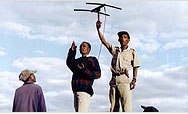You are here » Home » Environment » Water » Climate Change, Climate Variability, and Natural Disasters
Climate Change, Climate Variability, and Natural Disasters
The gradual warming of the earth’s atmosphere may mean that we are entering a period of increased frequency and severity of climate-related disasters, such as drought, flooding, and catastrophic storms. The dual forces of global warming and poor human management choices regarding land and water resources combine to cause such “natural” disasters, and poor planning and preparation exacerbate the level of damage experienced.
Impacts of Climate Change on Ecosystems
The health and productivity of ecosystems are fundamental to sustainable development, but they may face increasing threats from global warming in the coming decades. Climate change will potentially affect the geographic location of ecosystems and the structure and function of biological communities, thus influencing their ability to provide ecological goods and services. Many scientists believe that climate change will occur at a rapid rate relative to the speed at which ecosystems can adapt and reestablish themselves. Ecosystem changes in either inland aquatic or coastal systems can have major negative effects on freshwater supplies, biodiversity, fisheries, and important foreign revenue earning industries, such as tourism.
The Added Value of Forest and Wetland Conservation
Forests and wetlands are needed to absorb and slow floodwaters, yet on a global scale these resources are disappearing at alarming rates. Deforested areas can worsen droughts and floods, increase soil loss, represent lost habitat for birds and insects that pollinate crops and control pests, and result in the loss of carbon sinks. Human exploitation of natural resources weakens the ability of natural systems to mitigate the effects of weather-related events and places more people at greater risk in the short term, and places ecosystems and water resources at greater vulnerability.
Impacts of Climate Change on Water Supply
Such change could have equally serious implications for future water supply in some regions. It is predicted that climate change will increase the frequency and magnitude of droughts, floods, and destructive storms in specific regions. Floods are likely to become more problematic in many temperate and humid regions, necessitating advanced planning, flood forecasting, and even greater attention to well-developed emergency response networks to avoid significant loss of life and property. Some semi-arid regions are in turn likely to become more vulnerable to drought and/or flood-drought cycles that will similarly necessitate stepped-up efforts at integrated water resource management (IWRM) at the river basin scale. Although increasing human demand for freshwater is the largest challenge facing water resource managers, substantially altered hydrological cycles as a result of future global warming can make their task even more difficult.
The Cost of Adapting to Sea Level Change
Climate warming resulting in sea level rise (SLR) will likewise place additional, significant stress on coastal systems. Humans are directly responsible for the elimination of half of the world’s wetlands during the last century, and SLR will place stress on coastal wetlands as they “migrate” inland. SLR may put two-thirds of the world’s largest cities at risk during the next century. Further loss of mangroves and coral reefs could subject tens of millions of people to additional flooding and property damage from storm surges. The value of mangroves for flood control alone has been estimated at $300,000 per linear kilometer along some coasts in Malaysia, which represents the cost of building rock walls to protect coastal infrastructure. Planning for and adapting to projected SLR is least costly when done before land-use options are foreclosed. A one-meter increase in sea level, would displace tens of millions in Bangladesh alone in the absence of adaptation measures.
Responding to Climate Change
To adapt to and mitigate natural disasters, climate variability, and global climate change, water resources managers must begin work on many fronts to ensure that economic and land-use policies and conditions are in place to guide appropriate private sector investment and resource use patterns. Inappropriate land-use zoning and perverse subsidies for disaster insurance (as well as water and other resources) must be replaced with measures and incentives that promote risk and vulnerability reduction and the restoration of healthy ecosystems. The long-term environmental consequences of resource use must also be addressed with integrated planning that involves people responsible for disaster response and water resources management. A “least-cost” approach will necessarily be proactive rather than reactive, and will make full use of science and the wide range of tools, methods, and technologies now available to aid in disaster forecasting and mitigation.
USAID’s Disaster-related Investments
USAID investments related to disasters can be sorted into two broad categories: those dealing with forecasting, prediction, preparation and mitigation of disasters, and those dealing with response after the fact. To some extent, reconstruction associated with the response phase often seeks to build in better response to future disasters.
Application of U.S. government expertise in forecasting and monitoring has the potential to save billions of dollars both domestically and abroad, resources that would otherwise be lost in natural disasters or result from disrupted economies, human health problems, or ecological breakdown due to extreme storm and flood events. For example, studies in the U.S. have shown that advanced warning can dramatically reduce storm and flood damages, and has a benefit-cost ratio anywhere from 2 to 100 times the investment in hydrological monitoring technologies and warning systems.
Learn more about USAID’s Climate Change Program.
Back to Top ^
|


